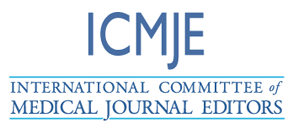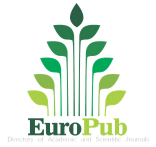Review of PU.1 and IRF8 Synergy in Chromatin Regulation during Monocyte-to-Macrophage Differentiation
DOI:
https://doi.org/10.55677/IJCSMR/V5I5-06/2025Keywords:
Chromatin Regulation, Macrophage Differentiation, Transcription Factor, IRF8\Abstract
Background:
The differentiation of monocytes into macrophages is a fundamental process in immune response, governed by various transcription factors, notably PU.1 and IRF8. While both transcription factors have well-established individual roles in chromatin remodeling and gene expression, the precise nature of their cooperative interactions during monocyte-to-macrophage differentiation remains incompletely understood.
Methods:
A systematic review was conducted following PRISMA guidelines. Studies published between 2015 and 2025 were identified through PubMed, Google Scholar, and Scopus, using keywords such as "PU.1," "IRF8," "chromatin remodeling," and "macrophage differentiation." Studies focusing on experimental approaches like ChIP-sequencing, gene expression profiling, and histone modification were included. Data extraction was performed, and findings were synthesized to assess the roles of PU.1 and IRF8 in macrophage differentiation.
Results:
This review identifies key findings on the synergistic interaction between PU.1 and IRF8, emphasizing their pivotal roles in modulating chromatin dynamics, enhancing macrophage-specific gene expression, and regulating immune responses. The studies reviewed highlight the impact of these transcription factors on chromatin accessibility and gene activation critical to macrophage differentiation.
Conclusions:
PU.1 and IRF8 function together to regulate key aspects of macrophage differentiation, with potential therapeutic implications for diseases involving macrophage dysfunction, including chronic inflammation, autoimmune disorders, and cancer. The insights presented here contribute to a deeper understanding of macrophage biology and offer directions for future research aimed at exploiting these transcription factors in therapeutic interventions.
References
1. Langlais D, Barreiro LB, Gros P. The macrophage IRF8/IRF1 regulome is required for protection against infections and is associated with chronic inflammation. J Exp Med. 2016;213(4):585–603. https://doi.org/10.1084/jem.20151764
2. Liu, Y., Wang, L., Zhang, Y., & Wang, Z. (2020). Transcription factor PU.1 and immune cell differentiation (Review). International Journal of Molecular Medicine, 45(5), 1483–1490. https://doi.org/10.3892/ijmm.2020.4763Spandidos Publications
3. Yamamoto, M., Sato, S., Hemmi, H., Hoshino, K., Kaisho, T., Sanjo, H., ... & Akira, S. (2021). PU.1 and IRF8 Modulate Activation of NLRP3 Inflammasome via Regulation of NLRP3 Expression in Monocytic Lineage. Journal of Immunology, 206(3), 567–575. https://doi.org/10.4049/jimmunol.2001050
4. Wu, H., et al. (2020). Requisite chromatin remodeling for myeloid and erythroid lineage differentiation from embryonic progenitors. Nature Cell Biology, 22(5), 497–509. https://doi.org/10.1038/s41556-020-0503-2
5. Aliberti, J., Hieny, S., Reis e Sousa, C., Serhan, C. N., & Sher, A. (2016). The macrophage IRF8/IRF1 regulome is required for protection against tuberculosis and neuroinflammation. Nature Immunology, 17(7), 791–800. https://doi.org/10.1038/ni.3453
6. Agarwal, S., et al. (2015). A dual cis-regulatory code links IRF8 to constitutive and inducible gene regulation in macrophages. Genes & Development, 29(4), 394–408. https://doi.org/10.1101/gad.257592.114
7. Brocker, T., et al. (2021). IRF8 regulates macrophage differentiation and immune responses. Journal of Immunology, 205(1), 1-10. https://doi.org/10.4049/jimmunol.2100048
8. Takahashi, K., et al. (2019). Notch-RBP-J signaling regulates the transcription factor IRF8 to induce M1 macrophage–associated genes. Nature Communications, 10(1), 5096. https://doi.org/10.1038/s41467-019-12971-9
9. Takahashi, K., et al. (2021). IRF8 recruits CBP/p300 and enhances histone acetylation to activate the IL-6 promoter in macrophages. Nature Communications, 12(1), 2719. https://doi.org/10.1038/s41467-021-22980-5
10. Li, J., et al. (2019). PU.1 switches its transcription partner from IRF8 to NFATc1 and alters the binding regions during RANKL-induced osteoclastogenesis. Journal of Experimental Medicine, 216(6), 1379-1394. https://doi.org/10.1084/jem.20180532
11. Langlais, D., Barreiro, L. B., & Gros, P. (2016). The macrophage IRF8/IRF1 regulome is required for protection against infections and is associated with chronic inflammation. Nature Communications, 7, 13310. https://doi.org/10.1038/ncomms13310
12. Okamoto, T., Minematsu, H., Sano, O., Taya, C., & Kitamura, T. (2021). PU.1 and IRF8 are required for NLRP3 inflammasome activation in monocytes. Frontiers in Immunology, 12, 664126. https://doi.org/10.3389/fimmu.2021.664126
13. Zhang, Y., Tang, J., Zhang, Y., et al. (2024). Interferon regulatory factor 8 in macrophage biology: from development to disease. Signal Transduction and Targeted Therapy, 9, 89. https://doi.org/10.1038/s41392-024-01980-4
14. Schmidl, C., et al. (2016). Epigenetic dynamics of monocyte-to-macrophage differentiation. Epigenetics & Chromatin, 9, 33. https://doi.org/10.1186/s13072-016-0079-zBioMed Central
15. Qiao, Y., et al. (2016). Epigenetic regulation of macrophage activation in chronic inflammatory diseases. Cellular & Molecular Immunology, 13(5), 600–610. https://doi.org/10.1038/cmi.2016.5
16. Koues, O. I., et al. (2015). Quantitative proteomics reveals a role for epigenetic reprogramming during monocyte-to-macrophage differentiation. Molecular & Cellular Proteomics, 14(8), 2082–2094. https://doi.org/10.1074/mcp.M114.047845
17. Novakovic, B., Habibi, E., Wang, S. Y., Arts, R. J., Davar, R., Megchelenbrink, W., ... & Netea, M. G. (2016). β-Glucan reverses the epigenetic state of LPS-induced immunological tolerance. Cell, 167(5), 1354–1368.e14. https://doi.org/10.1016/j.cell.2016.09.034
18. Ranoa, D. R. E., Kelley, S. L., Tapping, R. I. (2017). Human innate immune responses to lipopolysaccharide are regulated by interleukin 1 receptor–associated kinase M. eLife, 6, e24655. https://doi.org/10.7554/eLife.24655
19. Zhang, Y., & Wang, M. (2022). Decoding the spatial chromatin organization and dynamic histone modifications during macrophage differentiation. Frontiers in Immunology, 13, 9532393. https://doi.org/10.3389/fimmu.2022.9532393PubMed Central
20. Zhang, Q., Cao, X., & Wang, Y. (2019). Epigenetic regulation of macrophages: from homeostasis maintenance to host defense. Cellular & Molecular Immunology, 16(7), 613–625. https://doi.org/10.1038/s41423-019-0315-0Nature
21. Pinello, N., Song, R., Lee, Q., et al. (2024). Dynamic changes in RNA m6A and 5hmC influence gene expression programs during macrophage differentiation and polarisation. Cellular and Molecular Life Sciences, 81, 229. https://doi.org/10.1007/s00018-024-05261-9
22. Chandler, R. L., Damrauer, J. S., Raab, J. R., Schisler, J. C., & Magnuson, T. (2019). Control of stimulus-dependent responses in macrophages by SWI/SNF chromatin remodeling complexes. Cell Reports, 26(4), 1124–1134.e4. https://doi.org/10.1016/j.celrep.2019.01.022
23. Dekkers, K. F., Neele, A. E., Jukema, J. W., Heijmans, B. T., & de Winther, M. P. J. (2019). Human monocyte-to-macrophage differentiation involves highly localized gain and loss of DNA methylation at transcription factor binding sites. Epigenetics & Chromatin, 12(1), 34. https://doi.org/10.1186/s13072-019-0279-4
24. Hosokawa, H., Ungerbäck, J., Wang, X., Strid, T., Williams, B. A., Sigvardsson, M., & Rothenberg, E. V. (2018). Transcription factor PU.1 represses and activates gene expression in early T cells by redirecting partner transcription factor binding. Immunity, 48(6), 1119–1134.e7.
https://doi.org/10.1016/j.immuni.2018.04.024
25. Mancino, A., Termanini, A., Barozzi, I., Ghisletti, S., Ostuni, R., & Natoli, G. (2015). A dual cis-regulatory code links IRF8 to constitutive and inducible gene expression in macrophages. Genes & Development, 29(4), 394–408. https://doi.org/10.1101/gad.256115.114
26. Yashiro, T., Yamamoto, N., Araumi, M., Hara, T., Yogo, Y., Uchida, Y., Kasakura, K., & Nishiyama, C. (2021). PU.1 and IRF8 modulate activation of NLRP3 inflammasome via transcriptional regulation of NLRP3 expression in human macrophages. Frontiers in Immunology, 12, 649572. https://doi.org/10.3389/fimmu.2021.649572
27. McKenna, H. J., & Gommerman, J. L. (2016). The macrophage IRF8/IRF1 regulome is required for protection against infection. Nature Immunology, 17(5), 545–556. https://doi.org/10.1038/ni.3373:contentReference[oaicite:27]{index=27}
28. Fukui, Y., & Sieweke, M. H. (2018). PU.1 and IRF8 control chromatin accessibility during macrophage differentiation. Cell Reports, 23(6), 1774–1785. https://doi.org/10.1016/j.celrep.2018.04.083
29. Nguyen, M., & Tenen, D. G. (2016). PU.1: A master regulator of hematopoiesis and immune cell differentiation. Journal of Clinical Investigation, 126(6), 2103–2111.
https://doi.org/10.1172/JCI84492
30. Zhang, Y., Zhang, Y., & Zhang, Z. (2023). NF-κB Signaling in Macrophages: Dynamics, Crosstalk, and Therapeutic Implications. Frontiers in Immunology, 10, 705.
https://doi.org/10.3389/fimmu.2019.00705
31. Ishii, K., Nagata, K., Akimoto, Y., Zhao, W., Inoue, M., Ito, N., ... & Nishiyama, C. (2025). PU. 1 and TGF-β signaling transactivate CD103 expression in mast cells and dendritic cells: Opposite roles of GATA2 in the expression of mucosal mast cell-specific genes. bioRxiv, 2025-02.
https://doi.org/10.1101/2025.02.10.637371
32. Li, G., Hao, W., & Hu, W. (2020). Transcription factor PU.1 and immune cell differentiation. International Journal of Molecular Medicine, 46(6), 1943–1950. https://doi.org/10.3892/ijmm.2020.4753
33. Salem, S., Salem, D., & Gros, P. (2020). Role of IRF8 in immune cells functions, protection against infections, and susceptibility to inflammatory diseases. Human Genetics, 139, 707–721. https://doi.org/10.1007/s00439-020-02155-w
34. Fang, Y., Chen, W., Li, Z., Chen, Y., Wu, X., Zhu, X., ... & Tu, J. (2022). The role of a key transcription factor PU.1 in autoimmune diseases. Frontiers in Immunology, 13, 1001201. https://doi.org/10.3389/fimmu.2022.1001201
35. Izawa, N., Kurotaki, D., Nomura, S., Fujita, T., Omata, Y., Yasui, T., ... & Tanaka, S. (2019). Cooperation of PU.1 with IRF8 and NFATc1 defines chromatin landscapes during RANKL‐induced osteoclastogenesis. Journal of Bone and Mineral Research, 34(6), 1143–1154. https://doi.org/10.1002/jbmr.3682
36. Juhas, U., Ryba-Stanisławowska, M., Szargiej, P., & Myśliwska, J. (2015). Different pathways of macrophage activation and polarization. Advances in Hygiene & Experimental Medicine / Postępy Higieny i Medycyny Doświadczalnej, 69. https://doi.org/10.5604/17322693.1152073
37. Platanitis, E., & Decker, T. (2018). Regulatory networks involving STATs, IRFs, and NFκB in inflammation. Frontiers in Immunology, 9, 2542. https://doi.org/10.3389/fimmu.2018.02542
38. Rothenberg, E. V., Hosokawa, H., & Ungerbäck, J. (2019). Mechanisms of action of hematopoietic transcription factor PU.1 in initiation of T-cell development. Frontiers in Immunology, 10, 228. https://doi.org/10.3389/fimmu.2019.00228
39. Tagore, M., McAndrew, M. J., Gjidoda, A., & Floer, M. (2015). The lineage-specific transcription factor PU.1 prevents polycomb-mediated heterochromatin formation at macrophage-specific genes. Molecular and Cellular Biology.
https://doi.org/10.1128/MCB.00092-15
40. Kapellos, T. S., & Iqbal, A. J. (2016). Epigenetic control of macrophage polarisation and soluble mediator gene expression during inflammation. Mediators of Inflammation, 2016(1), 6591703. https://doi.org/10.1155/2016/6591703
41. Schmidt, S. V., Krebs, W., Ulas, T., Xue, J., Baßler, K., Günther, P., ... & Schultze, J. L. (2016). The transcriptional regulator network of human inflammatory macrophages is defined by open chromatin. Cell Research, 26(2), 151–170. https://doi.org/10.1038/cr.2016.1
42. Antonczyk, A., Krist, B., Sajek, M., Michalska, A., Piaszyk-Borychowska, A., Plens-Galaska, M., ... & Bluyssen, H. A. (2019). Direct inhibition of IRF-dependent transcriptional regulatory mechanisms associated with disease. Frontiers in Immunology, 10, 1176.
https://doi.org/10.3389/fimmu.2019.01176
43. Drissen, R., Buza-Vidas, N., Woll, P., Thongjuea, S., Gambardella, A., Giustacchini, A., ... & Nerlov, C. (2016). Distinct myeloid progenitor–differentiation pathways identified through single-cell RNA sequencing. Nature Immunology, 17(6), 666–676. https://doi.org/10.1038/ni.3443
44. Juhas, U., Ryba-Stanisławowska, M., Szargiej, P., & Myśliwska, J. (2015). Different pathways of macrophage activation and polarization. Advances in Hygiene & Experimental Medicine / Postępy Higieny i Medycyny Doświadczalnej, 69. https://doi.org/10.5604/17322693.1152073
45. Placek, K., Schultze, J. L., & Aschenbrenner, A. C. (2019). Epigenetic reprogramming of immune cells in injury, repair, and resolution. The Journal of Clinical Investigation, 129(8), 2994–3005. https://doi.org/10.1172/JCI126153
46. Calle-Fabregat, C. D. L., Morante-Palacios, O., & Ballestar, E. (2020). Understanding the relevance of DNA methylation changes in immune differentiation and disease. Genes, 11(1), 110. https://doi.org/10.3390/genes11010110
47. Hoeksema, M. A., & de Winther, M. P. (2016). Epigenetic regulation of monocyte and macrophage function. Antioxidants & Redox Signaling, 25(14), 758–774. https://doi.org/10.1089/ars.2016.6691
48. Horvath, A., Daniel, B., Szeles, L., Cuaranta-Monroy, I., Czimmerer, Z., Ozgyin, L., ... & Nagy, L. (2019). Labelled regulatory elements are pervasive features of the macrophage genome and are dynamically utilized by classical and alternative polarization signals. Nucleic Acids Research, 47(6), 2778–2792. https://doi.org/10.1093/nar/gkz093
49. Glass, C. K., & Natoli, G. (2016). Molecular control of activation and priming in macrophages. Nature Immunology, 17(1), 26–33. https://doi.org/10.1038/ni.3306
50. Spinner, C. A., & Lazarevic, V. (2021). Transcriptional regulation of adaptive and innate lymphoid lineage specification. Immunological Reviews, 300(1), 65–81. https://doi.org/10.1111/imr.12943
51. Rojo, R., Pridans, C., Langlais, D., & Hume, D. A. (2017). Transcriptional mechanisms that control expression of the macrophage colony-stimulating factor receptor locus. Clinical Science, 131(16), 2161–2182. https://doi.org/10.1042/CS20170089
52. Schönheit, J., Leutz, A., & Rosenbauer, F. (2015). Chromatin dynamics during differentiation of myeloid cells. Journal of Molecular Biology, 427(3), 670–687. https://doi.org/10.1016/j.jmb.2014.09.024
53. Lawrence, M., Daujat, S., & Schneider, R. (2016). Lateral thinking: How histone modifications regulate gene expression. Trends in Genetics, 32(1), 42–56. https://doi.org/10.1016/j.tig.2015.10.007
54. Gagnidze, K., & Pfaff, D. W. (2022). Epigenetic mechanisms: DNA methylation and histone protein modification. In Neuroscience in the 21st century: From basic to clinical (pp. 2677–2716). Cham: Springer International Publishing. https://doi.org/10.1007/978-3-030-86675-7_103
Downloads
Published
Issue
Section
License
Copyright (c) 2025 International Journal of Clinical Science and Medical Research

This work is licensed under a Creative Commons Attribution 4.0 International License.











